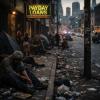
Breaking News
 US NAVY USELESS: China Activates "Land Route" to Drain Russian Silver
US NAVY USELESS: China Activates "Land Route" to Drain Russian Silver
 Lego's next-gen bricks make your creations interactive
Lego's next-gen bricks make your creations interactive
 Perhaps We Should Actually Be Focusing On Fixing America
Perhaps We Should Actually Be Focusing On Fixing America
Top Tech News
 The First Production All-Solid-State Battery Is Here, And It Promises 5-Minute Charging
The First Production All-Solid-State Battery Is Here, And It Promises 5-Minute Charging
 See inside the tech-topia cities billionaires are betting big on developing...
See inside the tech-topia cities billionaires are betting big on developing...
 Storage doesn't get much cheaper than this
Storage doesn't get much cheaper than this
 Laser weapons go mobile on US Army small vehicles
Laser weapons go mobile on US Army small vehicles
 EngineAI T800: Born to Disrupt! #EngineAI #robotics #newtechnology #newproduct
EngineAI T800: Born to Disrupt! #EngineAI #robotics #newtechnology #newproduct
 This Silicon Anode Breakthrough Could Mark A Turning Point For EV Batteries [Update]
This Silicon Anode Breakthrough Could Mark A Turning Point For EV Batteries [Update]
 Travel gadget promises to dry and iron your clothes – totally hands-free
Travel gadget promises to dry and iron your clothes – totally hands-free
 Perfect Aircrete, Kitchen Ingredients.
Perfect Aircrete, Kitchen Ingredients.
 Futuristic pixel-raising display lets you feel what's onscreen
Futuristic pixel-raising display lets you feel what's onscreen
 Cutting-Edge Facility Generates Pure Water and Hydrogen Fuel from Seawater for Mere Pennies
Cutting-Edge Facility Generates Pure Water and Hydrogen Fuel from Seawater for Mere Pennies
Honda's New Hydrogen Fuel Cell Produces More Power For Half The Price

Honda has a new hydrogen fuel cell system. The company claims it has more power and more durability in a smaller form factor that's also much cheaper to manufacture than the previous iteration. That fuel cell was co-developed with General Motors and used in the low-volume 2025 Honda CR-V e-FCEV, a plug-in hybrid hydrogen crossover.
While the hydrogen-powered CR-V can still be leased from a handful of California dealerships, Honda has parted ways with GM for the development of new fuel cell systems and went at it alone for this latest version.
Simply called the "Honda Next Generation Fuel Cell Module," the hydrogen-harnessing energy source has a rated power output of 150 kilowatts—almost double versus the 78 kW generated by the FCX unit co-developed with GM.
The output voltage of the new-gen module was bumped to a higher range and can now deliver between 450 and 850 volts, opening the door for plug-in hybrid vehicles that use 800-volt high-voltage batteries and a hydrogen fuel cell as a backup power source. The rated voltage output of the previous generation was between 275 and 600 volts.
The maximum net efficiency has also gone up from 56.8% to 59.8%, while the volume has been reduced from 557 liters to 300 liters. The size reduction, coupled with the increase in power, led to a significant bump in volumetric power density—from 0.14 kW/l to 0.50 kW/l. That said, the weight of the fuel cell module went up from 454 pounds (206 kilograms) to 551 lb (250 kg).
Compared to the module that was installed on the discontinued Honda Clarity, the new unit is touted as having a fifth of the manufacturing costs, while the durability has been increased by over 66%. Honda claims the new module will have half the production costs compared to the current cell.
The Japanese brand said the new fuel cell module will go into mass production in 2027, but didn't mention what it would power once it rolls off the assembly line. Hydrogen fueling stations are few and far between in the United States, with most of them clustered in California. That said, hydrogen fuel cells can also be used for power generators big and small, as well as heavy machinery, not just passenger cars. We'll have to wait and see what all Honda has in store for this new fuel cell module.
Toyota, which makes the Mirai FCEV, also announced a next-generation hydrogen module that will have more range and lower manufacturing costs.

 Not Worth a Continental
Not Worth a Continental

